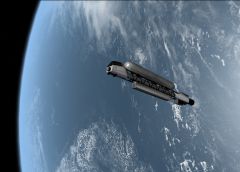Difference between revisions of "Shuttle-D"
| Line 59: | Line 59: | ||
== External links == | == External links == | ||
| − | * [http://www.orbithangar.com/searchid.php?ID=5936|Download on Orbithangar] | + | * [http://www.orbithangar.com/searchid.php?ID=5936| Download on Orbithangar] |
[[Category:Add-ons]] | [[Category:Add-ons]] | ||
[[Category:Vessel add-ons]] | [[Category:Vessel add-ons]] | ||
Revision as of 01:02, 17 December 2012
| Shuttle-D | |
|---|---|

| |
| Shuttle-D in low Earth orbit | |
| Description | |
| Role | NTR Transport |
| Full name | Shuttle-D |
| Crew | 2 |
| Passengers | N/A |
| First flight | N/A |
| Entered service | N/A |
| Manufacturer | N/A |
| Dimensions | |
| Length | 62.90 m |
| Height | 10.61 m |
| Wingspan | 4.40 m |
| Wing area | N/A |
| Masses | |
| Empty | 14,770 kg |
| Fuel | 11,000 kg Liquid Hydrogen |
| RCS fuel | 2440 kg Hydrogen Peroxide |
| Max. take-off | 79,000 kg |
| Inertia PMI | 14.00 / 16.00 / 2.20 |
| Performance | |
| Max. delta-v | 4,253 m/s |
| Max. accel | N/A |
| Stall CL | N/A |
| Stall AOA | N/A |
The Shuttle-D is a NTR Spacecraft created by BruceJohnJennerLawso for the Orbiter space flight simulator. It is designed as a low to medium thrust, high ISP cargo transport and propulsion stage for missions to lunar space and beyond.
Features and capabilities
The Shuttle-D was designed as a cargo transport, inspired by the Shuttle-A included with the standard Orbiter package.
Launched onto a suborbital trajectory by a Themis launch vehicle, the Shuttle-D uses its NTR engine to provide the final velocity boost to Low Earth Orbit, with 3,000-4,000 m/s of Delta-V typically remaining. This can then be used to place the vessel on a TLI, TMI, or trajectory to many other points in Near Earth Space.
The Shuttle-D was also designed as a cargo transport, able to carry a maximum of 50,000 kg of UCGO cargo in 18 slots. Actual payload to orbit may depend on the launch vehicle used and its abilities, with 10,000 kg being a realistic target with the Themis-A launch vehicle. UMMU is alsoadded, being able to carry 2 crewmembers with an oxygen supply for roughly 2 years 3 months. Crewmembers EVA'ed through the main dock can also activate the payload bays and the airlock via UMMU action areas.
The Shuttle-D can be flown via the Glass Window view or the Virtual Cockpit, which features a pair of functional MFD's. Vessel status can be monitored via various information displays on the HUD and the payload bays gear are controlleable from there as well. Future versions may also include 2d panel displays and more displays in the Virtual Cockpit.
The RCS thrsters use Hydrogen Peroxide monopropellant fuel for attitude control and course corrections. The relatively low ISP (1.6 kN·s/kg in Vacuum) makes efficient use of RCS fuel important throughout a mission.
History and evolution
The Shuttle-D was originally inspired by the Shuttle-A cargo transport included with the standard Orbiter installation. Although originally designed with capabilities similar to the Shuttle-A, the design concept evolved in its later stages towards a more realistic design, based off of current or near term technology. The engine design was based off of the Russian RD-0410 Soviet NTR design, allowing for a high ISP, medium thrust engine in a much smaller package than the American NERVA. The largest current design flaw as of the 1.0 release is the lack of any type of launch abort system, the absence of which could prove extremely dangerous for a real spacecraft. This may be included in future releases of the Shuttle-D.